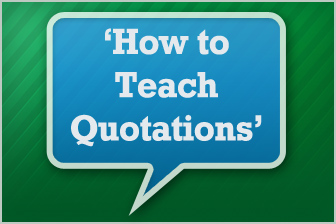Lily Tomlin as Edith Ann once said, “I like a teacher who gives you something to take home to think about besides homework.” Besides taking this as great teaching advice, we are reminded that teaching our students how to use quotations in their writing is very important.
If you have not spent some class time reviewing and using quotations with your students, the following activities may give you some ideas on how to approach the topic.
How to Teach Quotations in Your ESL Classroom
-
1
In Quotes
Do your students know what a quotation is? Ask them. If they say it is someone’s exact spoken words written down, they are correct. Then discuss with them how quotations come from dialogue. That dialogue is a conversation between people, and that at least two people participate in a dialogue. Let your students see examples of quotations. Try using both a comic strip and a newspaper article that quotes someone. How are the two quotations different? Encourage your students to notice that the newspaper quote uses quotation marks. Discuss with your students why they use quotation marks in the newspaper. Look for answers like it separates the quoted material from what the writer says and it shows it is the person’s exact words.
-
2
Have A Chat
With your students, brainstorm a list of topics they might want to have a conversation about. You can do this either as a class or in small groups or pairs. Then have students partner with one another to talk about whatever topic they chose. They should try to have a normal, back and forth conversation. Stop the pairs after just a couple of minutes and ask them to think back about what they said. Then have them write down their words. For this activity, they should use speech bubbles like those on the comic strip or simply list the sentences as bullet points (no need for quotation marks), but they should not put their names on the paper. Give your class as much or as little time as you would like to record their conversations, and then collect all the papers. Now redistribute the papers to the class making sure that no pair gets their own papers. Let your students take turns reading the dialogue in front of the class and trying to guess whose conversation it was originally.
-
3
Can I Quote You
The time has come for you to review with your students the proper way to quote someone in their writing. Reinforce that they should use quotation marks on either side of the quote. You can be sure students understand this by placing pages with large quotation marks on either side of a student’s head while he or she is speaking. Then allow another student to speak while holding the quotes around his or her head. Also, make sure your students understand that they must use a comma before introducing a quotation. For example, Alex said, “I hate potatoes, but I love French fries.” If they are starting the sentence with the quote, they should end that quote with a comma rather than a period if the sentence continues after the quote. “I like potato chips best,” Julie answered. The end of the sentence then finishes with a period. Your students should also know that it is okay to use an exclamation point or a question mark within the quote even if there are other words after the quotation.
Now that your students have dialogues from another pair and are clear about how to punctuate a quotation in their writing, ask each student to act like a reporter, writing a short piece on the topic discussed in the dialogue. They can agree or disagree with the original dialogue or share additional information about the topic. It really does not matter what they write as long as they are correctly using quotations from the original dialogue.
For homework, have your students interview someone at home on a topic of their choosing and write another article using at least two quotations from that person. When students have handed in their work, compile both assignments into a class newspaper, and give each student a copy to read and take home to show the person that he or she interviewed.
Once students have practiced using quotations from their classmates, encourage them to use quotations in their own writing when it is effective.
You may want to show them how to use a dictionary of quotations searching for a quote by speaker or by topic. The need to use quotations in one’s writing only increases with the educational level of your students. The earlier your students understand this concept, the more prepared they will be for research assignments in the future.
P.S. If you enjoyed this article, please help spread it by clicking one of those sharing buttons below. And if you are interested in more, you should follow our Facebook page where we share more about creative, non-boring ways to teach English.








